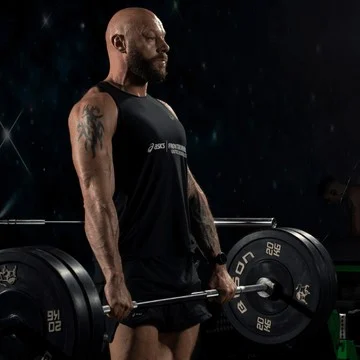
Strength
Exploring Testosterone Replacement Therapy
As men age, their testosterone levels naturally decrease, leading to a variety of symptoms that can affect their quality of life. Testosterone replacement therapy (TRT) is a treatment option that can help alleviate these symptoms and improve overall well-being.
1 min read
Published on
May 24, 2023
Written by
EDGE
Share this article
UNDERSTANDING TESTOSTERONE
Testosterone is produced in the testicles of men. It plays an important role in the development of male sexual characteristics such as muscle mass, body hair, and a deep voice. Testosterone is also involved in the production of sperm and the regulation of bone density.
DOES TESTOSTERONE DECLINE WITH AGE?
As men and women get older, the testes in men and the ovaries in women gradually produce less testosterone. Levels will start to decline in men when they turn 30, reducing at about 1% per year[1].
WHAT IS TESTOSTERONE REPLACEMENT THERAPY (TRT)
Testosterone replacement therapy (TRT) is a medical treatment designed to supplement or replace testosterone in men. TRT involves the administration of testosterone through various methods such as injections, gels, patches, or pellets. It is commonly prescribed to men who are diagnosed with low testosterone (hypogonadism). TRT aims to alleviate the symptoms of low testosterone and improve overall well-being. TRT should only be initiated after a thorough evaluation and diagnosis by your GP or a qualified healthcare professional.
TYPES OF TRT TREATMENTS
TESTOSTERONE INJECTIONS
Testosterone injections are one of the most common forms of TRT. They are typically given every two to four weeks and can be administered at home or in a doctor’s office. The injection is usually given in the muscle of the buttocks or thigh.
Testosterone injections can have side effects such as acne, mood swings, and increased risk of blood clots.
TESTOSTERONE GELS AND PATCHES
Testosterone gels and patches are another form of TRT. The gel is applied to the skin once a day, and the patch is applied to the skin once every 24 hours. Both methods are easy to use and can provide a steady dose of testosterone throughout the day.
Testosterone products, including gels and patches, can have side effects such as skin irritation, breast enlargement, and increased risk of prostate cancer.
We recommend using gloves to apply gels if you’re thinking of doing a blood test, as the gels can contaminate the sample.
ORAL TESTOSTERONE SUPPLEMENTS
Oral testosterone supplements are less commonly used than injections, gels, or patches. They are typically taken twice a day and can have side effects such as liver damage and decreased HDL cholesterol levels.
TESTOSTERONE PELLETS
Testosterone pellets are small, rice-sized pellets that are implanted under the skin every three to six months. They are a relatively new form of TRT and are not currently licensed in the UK.
TRT is not suitable for everyone. It is typically recommended for men who have low testosterone levels due to medical conditions such as hypogonadism or chemotherapy, or age-related hypogonadism in men, also known as late-onset hypogonadism or andropause, refers to a decline in testosterone levels that occurs naturally with ageing. It is important to discuss the risks and benefits of TRT with a doctor before starting treatment.
Other lifestyle changes such as exercise, healthy diet, and stress reduction can also help naturally increase testosterone levels. It is important to discuss these options with a doctor to determine the best course of treatment.
BENEFITS OF TESTOSTERONE REPLACEMENT THERAPY
TRT can offer many benefits to men who are experiencing symptoms of low testosterone, including:
IMPROVED ENERGY LEVELS
Low testosterone levels can lead to feelings of fatigue and low energy levels. TRT can improve energy levels, making it easier to perform everyday activities and exercise. Men who undergo TRT often report feeling more productive and motivated throughout the day.
While TRT can improve energy levels, it is not a substitute for a healthy lifestyle. Eating a balanced diet, getting regular exercise, and getting enough sleep are all important factors in maintaining optimal energy levels.
INCREASED MUSCLE MASS AND STRENGTH
Testosterone is an important hormone for building and maintaining muscle mass. If you’ve been diagnosed with low testosterone, then TRT can help one of the side effects of loss of muscle mass and strength, making it easier to exercise and perform physical activities. This can also lead to an improvement in body composition and overall physical appearance.
However, it is important to note that TRT alone may not lead to significant muscle gain. Regular exercise and a healthy diet are also important factors in building and maintaining muscle mass.
ENHANCED SEXUAL FUNCTION
TRT can help improve sexual function, including increased sex drive, improved erectile function, and enhanced sexual satisfaction. This can improve overall quality of life for men with low testosterone levels.
It is important to note that TRT may not be suitable for all men with sexual dysfunction. Other underlying conditions, such as cardiovascular disease, may need to be addressed in order to improve sexual function.
IMPROVED MOOD AND MENTAL HEALTH
TRT can help improve your mood and mental health, leading to a better overall sense of well-being. Studies have shown that TRT can improve symptoms of depression and anxiety in men with low testosterone levels.
However, it is important to note that TRT may not be suitable for all men with mood disorders. Other underlying conditions, such as thyroid disorders, may need to be addressed in order to improve mood and mental health.
SIDE EFFECTS OF TESTOSTERONE REPLACEMENT THERAPY
Common side effects of TRT can include acne, oily skin, increased red blood cell count, swelling in the ankles, breast enlargement or tenderness, and sleep apnoea. In some cases, TRT may also lead to a decrease in sperm production[2] and fertility. It is crucial to work closely with your GP to monitor hormone levels and adjust the dosage accordingly to minimise the risk of side effects.
There may be certain contraindications or interactions with other medications or underlying medical conditions, so a thorough evaluation and ongoing supervision are essential. Overall, the benefits of TRT often outweigh the potential side effects when used appropriately and under medical supervision.
Before discussing your suitability for TRT you should check your levels. An early morning fasting sample is important as you need to establish your natural peak testosterone levels to understand whether it is low.
Medically Reviewed

This article has been reviewed by our medical expert
Our expert Dr Thom Phillips works in NHS general practice and has a decade of experience working in both male and female elite sport. He has a background in exercise physiology and has published research into fatigue biomarkers.
Get 10% off your first order
Want regular tips on how to make the most of your results? Join our newsletter and we'll give you 10% off your order!